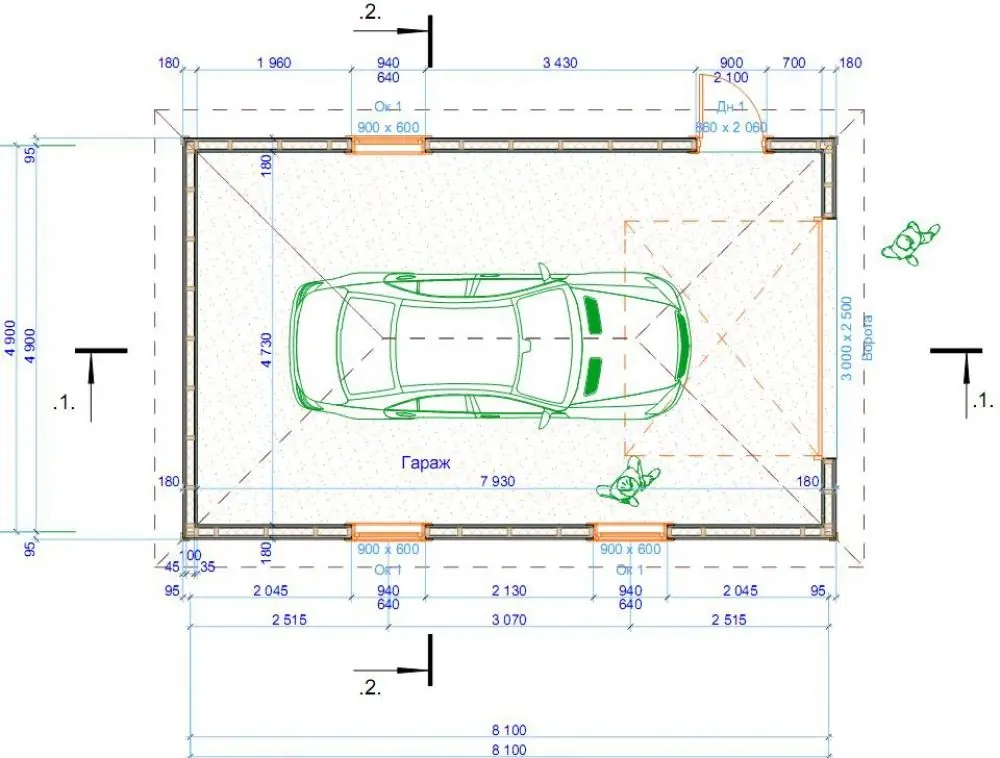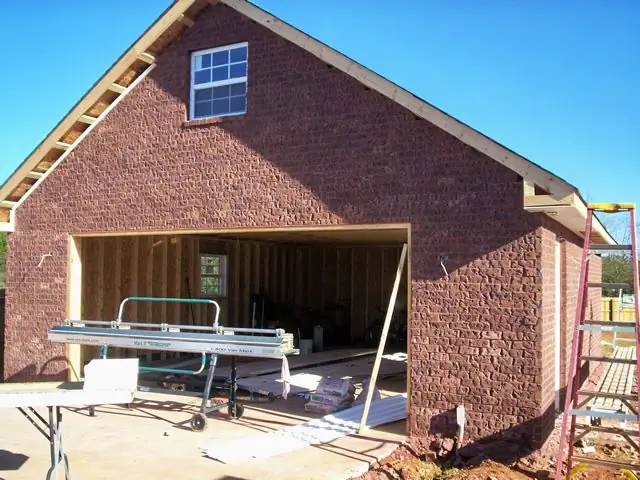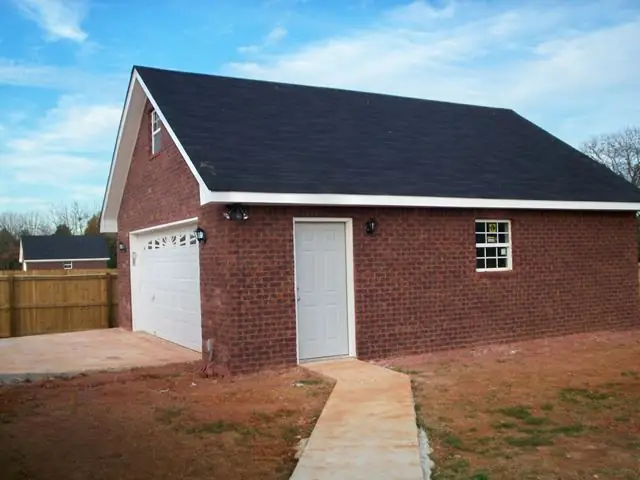Modern technologies do not stand still. This gave impetus to the transition to more modern alternative materials for construction. However, most motorists today prefer to build brick garages. The main explanation for this is the characteristics of the material, among which should be highlighted: strength durability reliability.
If you also decide to build such a structure, you must choose the type of structure, which can be wall-mounted, built-in or look like a separate building. Garages attached to the main dwelling are very convenient, since you can enter them from the house, from the side or from the front. One of the walls will be heated together with the house, which will save your energy consumption.
Built-in garages are usually laid at the construction stage, such solutions have their advantages, namely convenience and space saving. The most common option in our area is a separate building. Such a garage is usually lined up with a fence so that the gate faces the street.
Creating the most successful project

Before you start building a brick garage, you must create a blueprint for it. At this stage, important tasks are solved. Among them, it is worth highlighting whether the garage will be used as a parking lot for a car or you plan to operate it for inspecting and repairing a car. In this regard, it is important to decide whether a cellar or a viewing hole is needed.

Sometimes a brick garage project provides for an attic. At the second stage, you will need to determine the size of the building. They are chosen taking into account the area where the construction will be carried out. It is important to consider the tasks that the garage will have to perform. If it is only needed to store the car, then the dimensions can be as follows: 3 x 5.5 m. If there is an inspection pit or cellar, then the dimensions will be different, as in the case when additional equipment needs to be installed inside.
Terrain markings
Before building a brick garage, it will be necessary to mark the territory. To do this, take care of the availability:
- pegs;
- roulettes;
- sledgehammer or hammer;
- long rope.
The latter can be replaced with a nylon 40-meter cord. There should be about 10 pegs, their length is 40 cm. The tape measure should be at least 5 m. As soon as all the tools are prepared, the place for construction should be cleared.
Pegs are driven into the corners of the future building, while the specified dimensions should be followed. Pegsconnected with cord or rope. This will prepare the ground for the next step.
Earthworks
The brick garage is quite heavy, so it will require a foundation. Based on the markup, you should dig a trench under the base. This can be done manually or by ordering an excavator, which will cost more. For a garage, a strip foundation is suitable, the width of which is 40 cm or more. The depth of the base can vary from 60 to 120 cm, which will depend on the line, soil freezing. The average depth of the base is 100 cm. Given these dimensions, you must dig a trench, keeping an eye on the verticality and evenness of the walls. The bottom should not be loose. To improve the quality of the foundation at the bottom, you can make a 5 cm pillow of sand or gravel, compacting it.
Filling the foundation
When building a brick garage, the next step is to start pouring the foundation. The simplest solution would be a concrete structure. To implement the idea, it is necessary to lay a rubble stone in the prepared trench, filling each row with cement mortar until the trench is filled. The stronger the foundation, the longer the building can stand. The degree of shrinkage of the garage, as well as the likelihood of cracks, depends on this.
For the solution, you must choose high-quality materials. To do this, high-grade cement is combined with a plasticizer, sand and water. The solution is mixed in a concrete mixer. A bucket of cement will need 2.5 buckets of sand. Add enough liquid to get the right consistency.
Building a brick garagewith your own hands, you can use the usual mortar for pouring the foundation. In this case, crushed stone is added instead of rubble stones. In this case, more mortar will be spent, and a reinforced mesh will need to be installed in the trench. If the ground is quite hard, the formwork is needed only in the ground part to form the base. It is made from boards set according to the level.
In order to prevent the spreading of cement, there should be no holes or gaps in the formwork. It must be reinforced with braces. Filling should be carried out in several layers, and not partially. After pouring, air is expelled from the solution, the concrete is compacted, and its surface is leveled with a trowel. After about a week, the cement will dry, but it will be possible to start masonry not earlier than in a month.
When building a solid brick garage, you will need to protect its basement from water ingress by providing a layer of waterproofing. To do this, roofing material is laid on the base in 2 layers. It can be covered with bitumen. Thanks to this, the walls will not absorb moisture from the soil, and the foundation will not collapse.
Masonry walls

Once the foundation is dry, you can start building walls. They can be formed into one brick if the construction is carried out in an area with a warm climate. When winters are cold, it is better to lay 1.5 bricks for insulation. It is important not to skew.
The mortar should have the same consistency throughout the masonry. To do this, you can use 3 parts of sand and one part of cement. It is important to followseam thickness, which should not be more than one centimeter. You can use a lath pattern when placing a brick.
Preparation for installation work

When you have finished with the foundation of the brick garage, you can prepare all the tools, among them:
- building level;
- lace;
- bricks;
- capacity;
- shovel;
- plummet;
- trowel;
- pick;
- buckets.
The walls should be built using chain laying technology so that one row covers the seams in another row. Start laying from the corners. When building walls, use the building level. By stretching a fishing line or rope between the two extreme bricks, you can achieve perfect horizontality.
Once the rows around the perimeter are laid out, you can raise the corners and pull the cord, continuing to work. If the roof is shed, you need to provide a slope for water flow. In this case, the end walls are made of different heights, while the upper edge of the walls is sloped. If the garage has a length of 6 m, a slope of 30 cm will be enough. For this, a slope of 5 cm is made for each meter.
Construction options for a two-story building

A two-story brick garage can be built in one of several ways. The first is the construction of an attic room made of wood; in this case, wooden beams will act as a ceiling. The second option is to usereinforced concrete slabs for the floor, while the walls of the second floor will also be made of brick. The first option is easier to implement, while the second floor has less load on the walls and foundation.
Attic can be built from wooden beams. First, the transverse beams are laid, which serve as the basis for the ceiling. Then you can start building the frame of the second floor and laying the roofing material. Two-story garages with monolithic floor slabs are erected using a crane. At the final stage, it is possible to finish the premises of the garage itself and the second floor, usually this is required to protect the brick from the outside. For this, plaster is used, and the inside is insulated with mineral wool. For external insulation, you can use foam, which will not only protect the brick from moisture, but also prevent it from freezing.
Finishing the garage from the inside

Inside, brick garages can be finished with different materials. For walls, for example, plaster can be used, and the floor is often poured with concrete screed. This approach meets most of the requirements for such buildings. In this case, the walls will be strong, fire-resistant, resistant to mechanical stress and durable. The need for repairs will not arise so soon.

Instead of the wet method, you can resort to dry plaster, which is known as drywall. Sheets are fixed to the wall on a specialglue or attached to a metal frame. The latter option is used when the surface has large distortions or the walls need to be insulated. However, this approach damages the free space in the garage.
Specialist recommendations
After reviewing the photos of brick garages, you can choose for yourself the most acceptable option for interior decoration. If you decide to use drywall, then you should purchase a fire-resistant and moisture-resistant material. Sometimes motorists resort to wall decoration with ceramic tiles. It gives surfaces accuracy, water resistance and fire resistance. It can be easily cleaned, even with detergents. To finish the garage, it is recommended to use porcelain stoneware or clinker versions of this finishing material.






